How To Draw Weeds That Could Be Flowers
Growing weed indoors is great considering you tin grow information technology whatsoever time of twelvemonth and y'all'll have complete control over the plant and what you lot put into it. Live in an apartment or a small house? Don't worry, you tin abound weed practically anywhere, even if you don't have a backyard or a lot of extra infinite.
Benefits of growing weed indoors
High-quality weed
Although it'due south more resource-intensive than growing outdoors and you will likely accept to spend more money on utilities to ability equipment, y'all can command every attribute of your grow environs and what yous put in your plant, allowing y'all to punch in your setup to grow some primo weed.
Adaptability
Different outdoor growing, you aren't tied to the sun and the seasons. You will be providing the entire environment the plants need to grow, including the grow medium—soil, rockwool, etc.—and regulating the amount of water and nutrients they receive, every bit well every bit controlling temperature, humidity, and more for them.
Multiple harvests
Y'all tin can allow your plants become as big as you want, and tin control when they flower and when you harvest, and you can start another batch correct abroad or whenever y'all desire. You can abound any time of year, even straight through winter or summer, and you'll get consequent crops each time.
Privacy and security
Even in legal states, you may want to muffle your crop from judgmental neighbors and definitely from potential thieves. Growing indoors allows you to grow discreetly behind a locked door.
How to gear up an indoor grow room
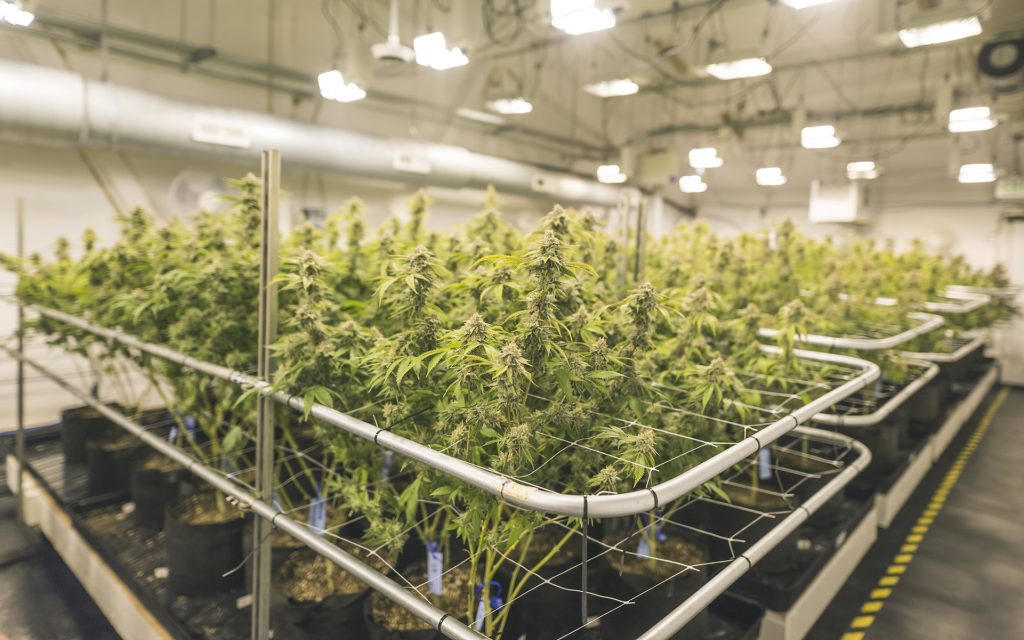
Below is a listing of things to consider and equipment y'all will demand to purchase to get started growing marijuana indoors.
Indoor space
You lot'll need a dedicated infinite for your marijuana plants—yous won't exist able to move them effectually. Ideally, the infinite is next to a window and so you can vent air from the grow space outside. Growing weed plants olfactory property! Specially when flowering kicks in, you'll desire to redirect air and so your house doesn't reek of weed.
A lot of people these days buy grow tents for their weed, but they aren't necessary. You can abound in a closet, tent, cabinet, spare room, or a corner in an unfinished basement. Just go along in mind that you'll need to tailor your equipment (and plants) to fit the space.
It'southward a good idea to offset small-scale—the smaller the abound, the less expensive it is to set up. Newbie mistakes will be less costly if you only take a scattering of plants. Additionally, most state laws only let for growing six plants, but some allow up to 12.
When designing your infinite, y'all'll need to take into account room for your plants, also as space for lights, fans, ducting, and other equipment. You'll also need space to work on the plants. Cannabis plants tin double in size in the early stages of flowering, so make certain yous have adequate head infinite!
Every space is unlike and at that place will be a learning curve to growing in yours.
Indoor climate
Cannabis, like all plants, prefers sure environmental conditions in order to thrive. Temperature, humidity, light intensity, and airflow are all factors that will need to be monitored and regulated in gild to keep cannabis healthy through its different phases.
Although yous'll exist controlling the climate inside the grow space, climate outside the grow space will bear on your plants. If the environment exterior your abound space is very warm or boiling, y'all'll take issues decision-making your abound infinite. Choose a cool, dry out area with gear up admission to fresh air from exterior.
If you're growing in a cold, wet basement, y'all might have to run a dehumidifier or heater to stabilize the environment. Conversely, if your infinite is besides hot, you might need to add actress fans or an AC to cool the plants down.
One trick to avoid hot temps is to have the grow lights on during the evening, when information technology'southward cooler exterior, and get out the lights off during the twenty-four hours when it's hot. This may help bring down the temps, but you'll only be able to work on the plants at nighttime when the lights are on.
Lights
Weed plants need different amounts of light during their vegetative and flowering stages. Y'all don't have to worry about this in an outdoor setting—the sun and the season dictate this—but when growing indoors, you will exist decision-making it.
Plants demand 18 hours of light a mean solar day when in the vegetative stage and 12 hours a day when flowering. The reduction in light from 18 to 12 hours a day is what triggers the flowering bike—when weed plants commencement to grow buds.
Because the amount of low-cal a constitute receives is so of import, you lot'll need to brand your indoor grow infinite light-tight. Light leaks during dark periods will misfile your plants and can cause them to produce male flowers or revert to a different stage.
Different lights produce different colors of light. Here'southward a brief rundown of the most pop types of cannabis grow lights used for indoor growing.
HID
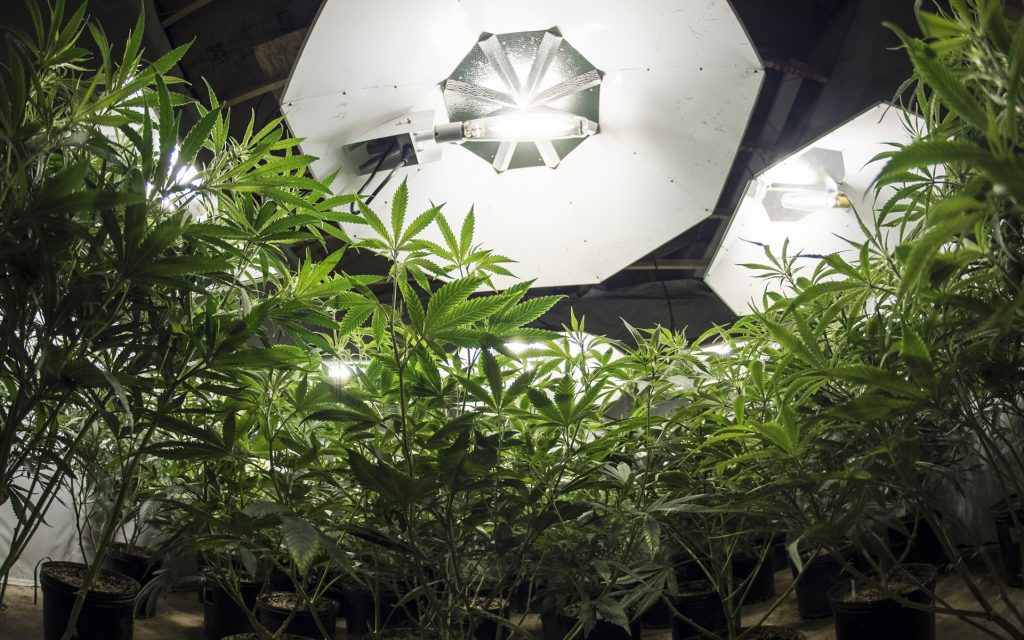
HID (high-intensity discharge) lights are the industry standard, widely used for their combination of output, efficiency, and value. They cost a chip more than incandescent or fluorescent fixtures, only produce far more light per unit of measurement of electricity used. Conversely, they are non as efficient equally LED lighting, but they cost much less.
The two master types of HID lamp used for growing are:
- Metal halide (MH) produces light that is blue-white and is generally used during vegetative growth.
- High pressure sodium (HPS) produces calorie-free that is more on the ruby-orange stop of the spectrum and is used during the flowering stage.
In add-on to bulbs, HID lighting setups crave a ballast and hood/reflector for each light. Some ballasts are designed for utilize with either MH or HPS lamps, while many newer designs will run both.
If you can't afford both MH and HPS bulbs, start with HPS as they deliver more light per watt. Magnetic ballasts are cheaper than digital ballasts, but run hotter, are less efficient, and harder on your bulbs. Digital ballasts are generally a better option, but are more than expensive. Beware of cheap digital ballasts, as they are oftentimes non well shielded and can create electromagnetic interference that volition impact radio and WiFi signals.
Unless you lot're growing in a large, open space with a lot of ventilation, you'll need air-cooled reflector hoods to mountain your lamps in, as HID bulbs produce a lot of heat. This requires ducting and frazzle fans, which will increase your initial cost just make decision-making temperature in your grow room much easier.
Fluorescent abound lights
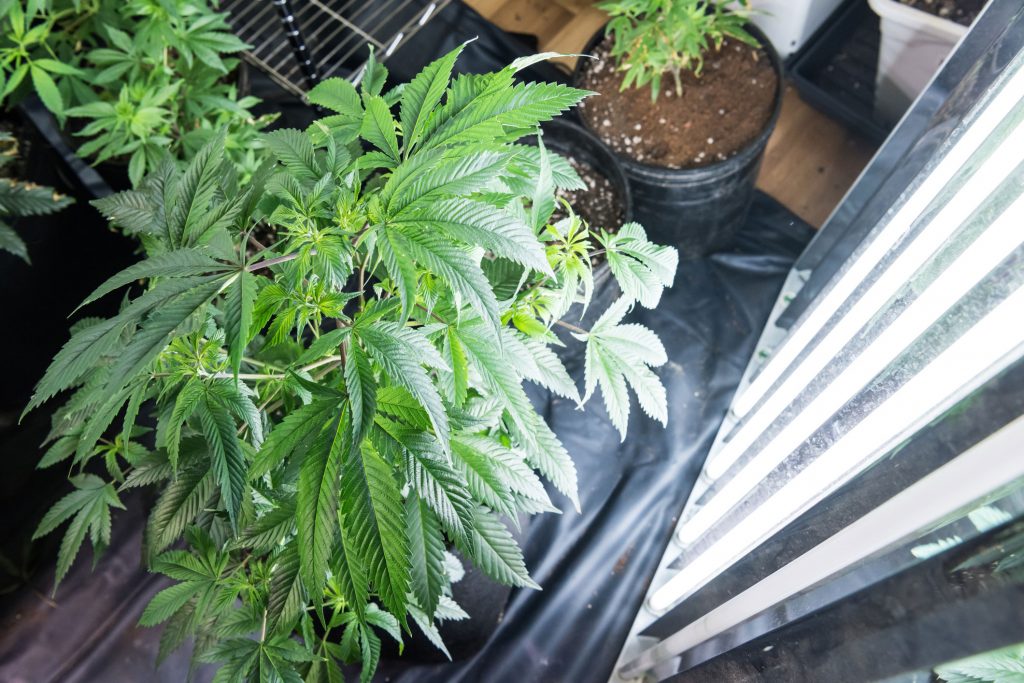
Fluorescent light fixtures, peculiarly those using high-output T5 bulbs, are quite popular with pocket-size-scale cannabis growers because:
- They tend to be cheaper to fix up, equally reflector, anchor, and bulbs are included in a single parcel.
- They don't crave a cooling system since they don't generate nearly the amount of oestrus that HID setups practice.
The principal drawback is fluorescent lights are less efficient, generating virtually xx-30% less lite per watt of electricity used; space is another business concern, as information technology would require approximately 19 iv-foot long T5 bulbs to equal the output of a unmarried 600 watt HPS bulb.
LED grow lights
Light emitting diode (LED) technology has been around for a while, and they are getting more than efficient all the fourth dimension. The main drawback to LED grow lights is their cost: well-designed fixtures can cost ten times what a comparable HID setup would.
But the benefits are great: LEDs last much longer, use far less electricity, create less oestrus, and the best designs generate a fuller spectrum of light, which tin can get bigger yields and better quality.
Check out our buying guide on indoor lights for more info.
Air circulation
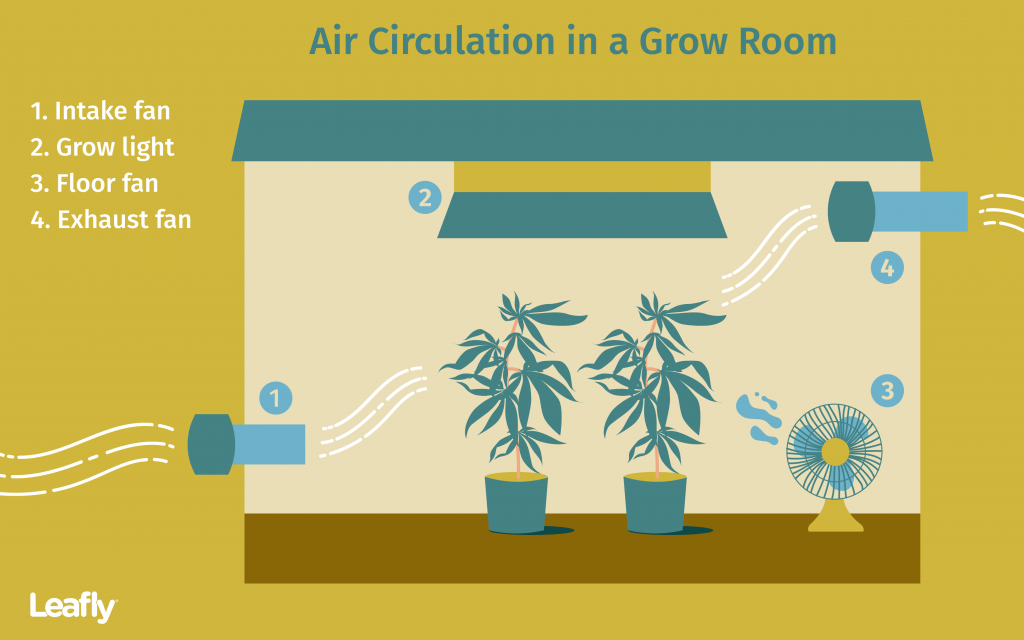
Plants need fresh air to thrive and carbon dioxide (CO2) is essential to the process of photosynthesis. This means you volition demand a steady stream of air flowing through your grow room, which will allow you to move hot air out of the space and bring cool air in.
This is hands achieved by placing an exhaust fan near the acme of the space to suck out warm air—warm air rises—and adding a port or passive fan on the opposite side of the space near the floor to bring in cool air. A complete air exchange throughout the entire grow space should occur once every infinitesimal or so.
Without proper airflow, a grow space tin can experience rapid changes in humidity or develop pockets of CO2 depletion, neither of which are good for establish growth. CO2 depletion can lead to nutrient lockout, and areas of loftier humidity are prone to pest infestation, mold, or mildew.
It's too a proficient idea to take oscillating fans to provide a constant breeze in your abound room as it will strengthen your plants' stems, making them stronger and healthier.
Setting up fans
For small spaces or tents, clip-on fans can be fastened to structures like walls, corners, or support beams. For larger grow rooms, use medium-sized oscillating fans or large floor models.
Fans should exist positioned to provide direct, even airflow throughout the garden. This typically involves using multiple fans that work together or fans that take oscillation capabilities.
There should exist a comfortable airflow both in a higher place and below the canopy, and fans shouldn't blow air directly onto plants—this can cause air current burn, which makes leaves recede into a claw-like deformation.
Dehumidifiers and ACs
If your infinite is too humid, you may demand to invest in a dehumidifier—also known as "dehueys." All the same, keep in mind that while dehueys will reduce humidity, they typically increase temperature—you may need more fans or an Air-conditioning when adding a dehumidifier.
Getting the right climate for your plants can be a frail residuum involving multiple pieces of equipment and likewise lots of electricity. This is part of what makes growing weed indoors more expensive than growing outdoors.
Fans are a must in a grow space to move air around, so purchase some of those before an AC unit. If you find that fans aren't bringing down the temperature enough, then you may want to invest in an Air conditioning.
Timers/Automation
You will definitely want to invest in a timer for your lights. Because the amount of light a plant receives dictates its vegetative or flowering stage, it's important to give it a consistent amount of low-cal every day, and that's done with a timer. It'due south a proficient thought to check your timer at least in one case a week to make sure it'south working properly.
Y'all can besides use a timer for your fans, but a thermostat is meliorate—you can fix information technology to a specific temperature, and the fans will plow on when it's too hot and turn off when it'due south also cold.
Virtually dehumidifiers and ACs accept built-in thermostats, but if they don't, you'll want to buy an external one.
For growers who accept a trivial actress money to spend and desire total control over their indoor garden, ecology controllers will let y'all to automate the procedure. These devices are essential for if you're away from the garden for a long catamenia of fourth dimension.
Y'all can connect a controller to fans, dehumidifiers, humidifiers, heaters, or air conditioners, and set thresholds whereby each device will power on and off based on your ideal ecology settings. Some units run autonomously, making changes based on set parameters, while others let you to control each chemical element via an app on a phone, tablet, or reckoner.
Regulating temperature and humidity in your indoor grow space
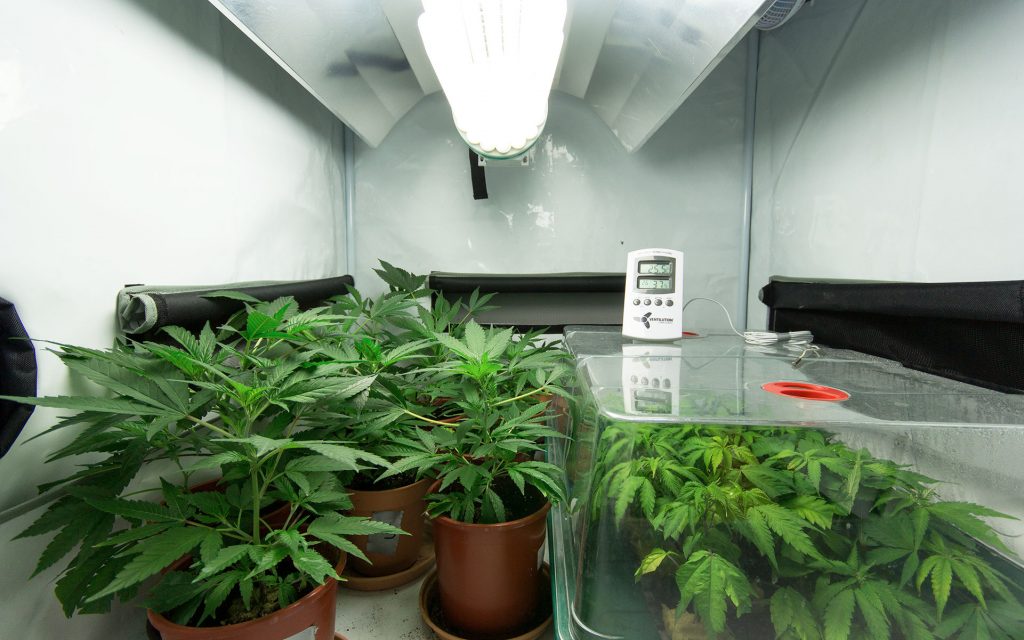
You lot'll need to ensure that temperatures remain within a comfortable range for your plants, between 70-85°F when lights are on and betwixt 58-70°F when off. Some varieties of cannabis—more often than not indicas—adopt the colder side of the range, while others—typically sativas—are more tolerant of loftier temperatures.
For the nigh part, weed prefers these temps at each growth stage for optimal wellness:
- Seedlings/clones: 75-85°F; ~70% relative humidity
- Vegetative growth: 70-85°F; 40-sixty% relative humidity
- Flowering: 65-80°F; twoscore-50% relative humidity
The 2 factors you lot need to command to dial in the environment are temperature and humidity.
Inevitably, at that place will be fluctuations of temperature and humidity in your cannabis garden. These fluctuations can occur both throughout a abound space as well as inside pockets inside a given room. They can also occur at different points within a given day or throughout a flavor as conditions alter in the surroundings outside your grow infinite.
It tin can be tricky getting the right remainder of temperature and humidity because they touch on each other—turning up your dehumidifier volition lower the humidity of your grow space, but information technology will likewise increase the temperature of the area. This in turn may crave you lot to plough on an AC unit—everything'southward continued!
Tools to measure temperature and humidity
Equip yourself with these cheap and easy-to-utilise tools to have measurements in your indoor cannabis setup:
- Thermometer: A basic one volition allow you to measure how warm or cool the environment is inside your garden.
- Hygrometer: This measures humidity, or more specifically, water vapor content in the air.
- Infrared thermometer, or IR thermometer (optional): IR thermometers use a detection device called a thermopile to mensurate surface temperatures. Although not necessary, these are helpful in finding out leaf temperatures, which will requite you an extra layer of knowledge on how to properly regulate environmental weather condition.
Regulating temperature
Controlling temperature in your indoor abound room or cannabis garden can be achieved by manipulating these factors:
- Lights: Different grow lights will give off different heat signatures. Hot lights such MH, HPS, and fluorescents produce much more heat than LEDs. Also, lights can be raised or lowered to alter temperature at the canopy level.
- Airflow: You tin can remove warm air (up high) out of the garden and bring in fresh cool air (downwards low) with fans and ducting. Fans tin also assistance commutation air throughout your awning, cooling leaves in the procedure.
- ACs: You may need to bring in an air conditioner to chop-chop cool the overall temperature of your grow space if it'due south also hot and fans aren't enough.
- Heaters: Some gardens may require warm air, especially during times when lights are off and not generating heat.
Regulating Humidity
Humidity is the amount of water vapor in the air. Here are some ways to control it in your marijuana grow room:
- Dehumidifiers: Dehueys remove moisture from the air but also increase temperature.
- Airflow: As with regulating temperature, regulating airflow will permit you to motion wet in and out of your grow space and control humidity—merely opening upward a space, i.east., opening the door to your grow room or tent, can bring down humidity.
- Humidifiers: A humidifier can add water vapor to a grow space and increases wet levels if it'south too dry.
- Water: In the absenteeism of a humidifier, you tin mist plants with a spray bottle to create extra moisture.
Soil and other media for growing weed indoors
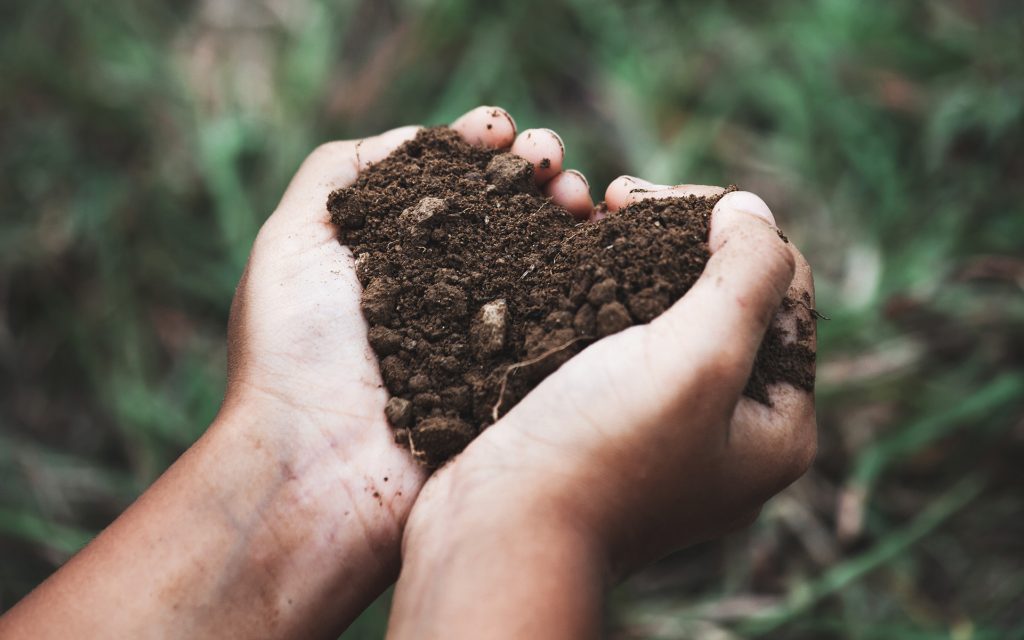
At that place are many unlike media to choose from, including good ol' fashioned pots full of soil, rockwool cubes, a hydroponic tray, and more than.
Soil is the virtually traditional medium for growing marijuana indoors, too equally the most forgiving, making it a proficient option for start-time growers. Any loftier-quality potting soil volition work, equally long as it doesn't contain artificial extended release fertilizer—like Phenomenon Gro—which is unsuitable for growing expert cannabis.
Proficient soil for cannabis relies on a healthy population of mycorrhizae and soil bacteria to facilitate the conversion of organic matter into nutrients that a plant tin can use. Alternately, you can use a regular soil mix so supplement your plants with liquid nutrients.
Finding the right soil for cannabis
For almost beginning-time gardeners, we recommend buying a quality potting soil that volition provide your plants with enough nutrients to become them through most of their growth wheel without having to add many amendments or liquid nutrients. This pre-fertilized soil—often referred to every bit "super-soil"—that can grow cannabis plants from start to finish without whatsoever added nutrients if used correctly.
You lot tin can brand this yourself by combining worm castings, bat guano, and other components with a skillful soil and letting information technology sit for a few weeks, or it can be purchased pre-made from a local plant nursery or grow shop.
While shopping for soil, you lot might be overwhelmed by the options bachelor at your local garden store. The soil blazon is the basic structure of your soil. From there, wait at nutrients, microorganisms, and other amendments that amend the soil. Your choices will be flooded with words similar:
- Perlite
- Worm castings
- Bat guano
- Biochar
- Peat moss
- Compost
- Fish meal
- Bone meal
- Glacier stone dust
- Plant food
These are simply some examples of amendments commonly used in different types of soils. Heavily amended soils will have long lists that break down all organic nutrients they contain. Some companies create soils that offering a corking structure with base nutrients, but allow y'all to fill in the gaps as yous desire.
Growing containers
What type of container you lot use will depend on the grow medium, the system, and the size of your plants.
Inexpensive options include standard plastic pots or cloth numberless, while some growers choose to spend more on "smart pots" or "air pots"—containers designed to enhance airflow to the plant'south root zone.
What size pot do I need?
Many growers will start plants in a one-gallon pot then transplant up to a bigger pot as plants go bigger. A lot of growers will transplant one time, from a one-gallon to a five-gallon pot, and harvest from there. If your plants go bigger, they may need a seven- or ten-gallon pot.
What to look for in a pot
Your cannabis wants a safe, salubrious place for root development. Without healthy roots, your cannabis will never thrive. Roots are in charge of water retention, nutrient absorption, anchoring the found, and they too facilitate vegetative growth.
Drainage is fundamental, as cannabis plants can get waterlogged and develop root rot. If you repurpose containers, be certain they have holes in the bottoms and set them in trays.
For a root organization to develop and thrive, they volition need the post-obit:
- Drainage: Water retentiveness is paramount for healthy plants—without it, your cannabis will wither and dice. But too much water volition waterlog your plant and lead to root rot, killing roots.
- Oxygen: Plant roots require oxygen to function properly. Choose a container that facilitates enough oxygen for root development without overexposing them to the elements—containers practise this though various styles of perforation.
- Nutrients: Roots require optimal conditions for food absorption to occur. This includes pH balance, optimal temperatures, and food availability.
- Space: Roots need enough of space to branch out. A container that is besides pocket-size will crusade it to get rootbound and choke the plant.
Traditional plastic containers
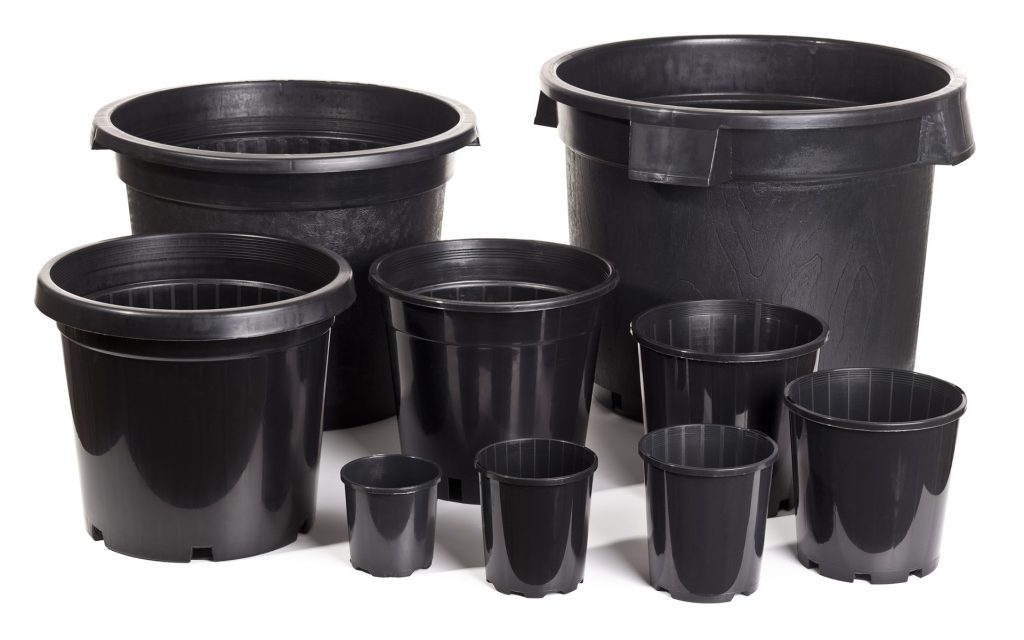
Standard plastic containers are a popular option for growers operating on a budget. These pots are inexpensive and provide the essentials for your plants.
Pros:
- Low overhead costs
- Solid drainage (plus it'south piece of cake to add more than holes)
- Transplanting is easy and inexpensive
Cons:
- Can't protect root systems from temperature fluctuations likewise
- Lack of durability which can cause cracks and structural damage over time
- May take airflow problems depending on the grow medium
Fabric containers
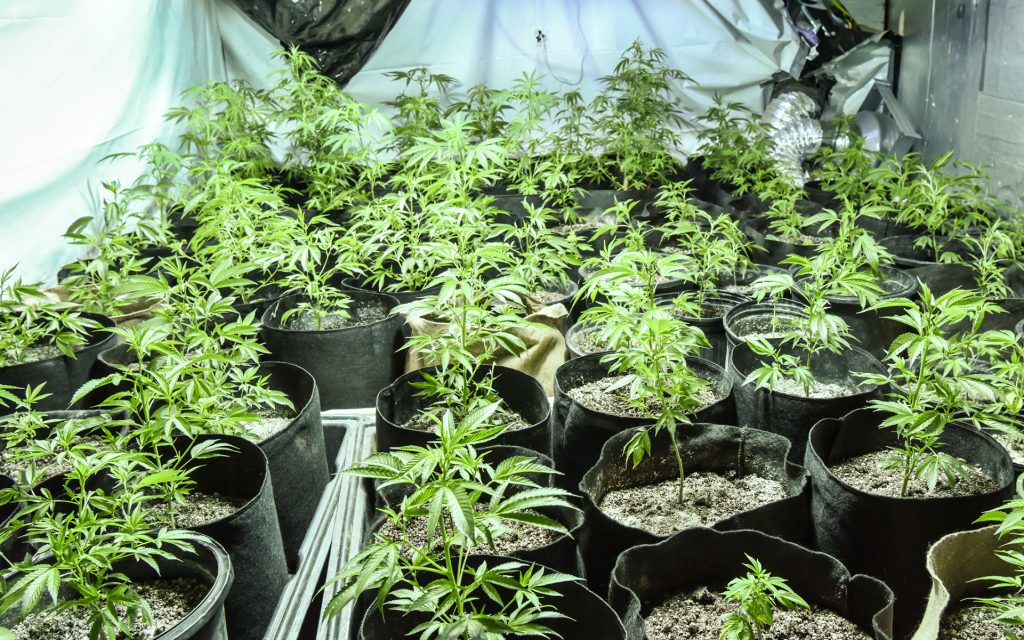
These are quickly becoming the standard. Roots in fabric pots grow to the outer edges and attempt to bypass the porous cloth wall but are cut back, allowing new growth to occur. This process, chosen "air pruning," results in a denser root composition which promotes healthy growth and development.
Pros:
- Promotes dumbo, healthy root systems
- Increased airflow to roots
- First-class drainage
Cons:
- Crave more attention and maintenance because they dry out rapidly. Notation: You can use larger pots to assistance dull drying.
- Flimsy structure can make constitute support challenging
Ceramic pots
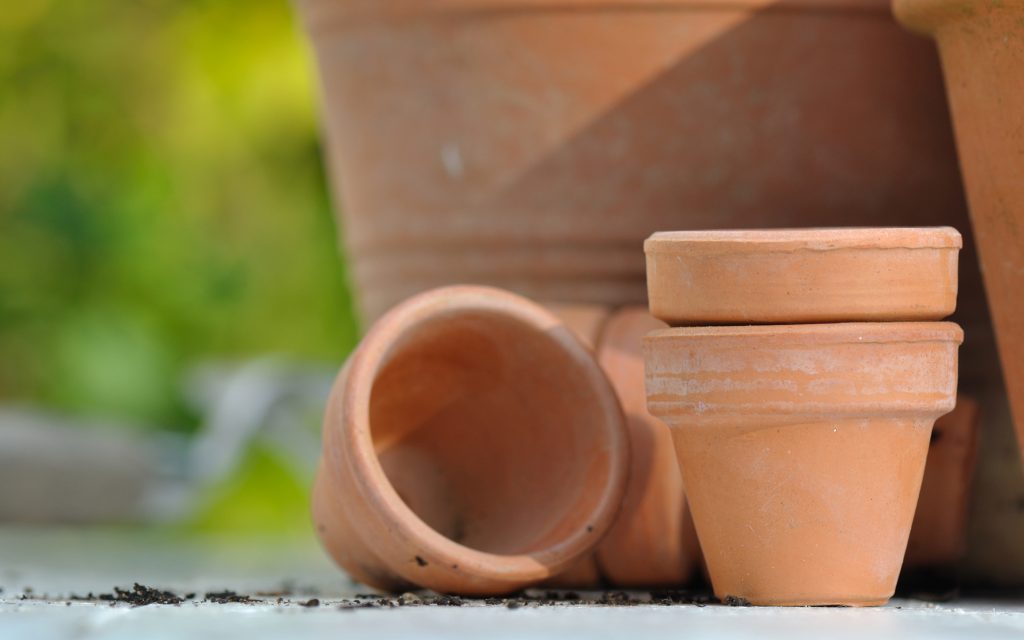
Terra cotta pots offer a unique set of benefits to growers in hot climates.
Pros:
- Blot moisture and retain lower temperatures during hot days
- Heavy weight helps to ballast larger plants
Cons:
- Less than optimal drainage; drilling holes into clay pots is possible just requires special tools and is labor-intensive
- Heavy weight makes it difficult to transport plants
Caring for your indoor cannabis plants
When starting with clones or seedlings, you'll want to cheque your plants every day because they're delicate and sensitive to environmental conditions. You may need to adjust temperature and humidity levels in your indoor grow space at beginning to hitting the sweet spot for your plants.
As your indoor weed plants abound, they'll need less attention, simply you'll still demand to check up on them every 2-3 days.
Watering and nutrients
When growing weed indoors, you'll likely take to add nutrients to your plants. You won't need to add nutrients every fourth dimension you water, simply go on a schedule where you water every other fourth dimension, or two on, one off.
Before watering, check the pH of your water and add pH Upwards or Down if needed.
If using nutrients, estimate how much water you'll need for all of your weed plants so you can mensurate and mix in the appropriate amount of nutrients.
Think, a common fault newbie growers brand is to overwater plants.
Check out our Guide on nutrients for more info.
Cheque for pests, mold, or food deficiencies
Y'all'll besides want to accept this time to bank check over your weed plants for pests, mold, or nutrient deficiencies.
Examine the tops and undersides of leaves for pests or discoloration—spider mites alive on the underside of leaves—as well as stalks and branches. Also, cheque the soil for pests.
Equipment
Make certain all equipment is on, no breakers have flipped, and everything is running smoothly. Check lights, timers, fans, dehueys, ACs, and anything else that plugs into the wall or has a battery.
Call back of all the equipment in your grow infinite equally organs in the torso—if one fails, the others will accept to work a lot harder for a bit, and then will fail in a matter of time.
Daily maintenance checklist for your indoor marijuana abound
- Water plants
- Check pH of water
- Measure out and mix nutrients
- Cheque plants and soil for pests, mold, nutrient deficiencies
- Prune/remove expressionless leaves on plants if needed
- Make up one's mind if plants need topping
- Make sure plants are spaced properly and not shading each other out
- Adapt level of lights if leaf tips are getting burned
- Bank check temperature and humidity in grow space
- Check equipment is running properly, i.e., lights, timers, fans, dehueys, etc.
Indoor marijuana grow timeline
The growth stages of marijuana tin can be broken down into four primary stages from seed to harvest:
- Formation (3-x days)
- Seedling (2-3 weeks)
- Vegetative (3-16 weeks)
- Flowering (eight-11 weeks)
Generally speaking, it takes anywhere from 10-32 weeks, or near iii-8 months, to fume what y'all've grown. (It'll be quicker if you start with a clone or an autoflower seed.)
That's a big variance, but it actually depends on how big yous want your plants and how ofttimes you desire to harvest—you can have multiple harvests of smaller plants, or less harvests of bigger plants.
For example, it takes less fourth dimension to grow three′ weed plants than 5′ plants; in the bridge of a twelvemonth, you lot can maybe abound four harvests of 3′ plants, or two harvests of five′ plants.
You'll likely yield almost the aforementioned corporeality of weed in both cases, merely more than harvests mean yous'll have fresh weed to fume more often and have more opportunities to grow unlike strains. Simply more harvests likewise means more than work in cleaning upwardly the space betwixt harvests, trimming, etc.
The biggest variability in how long a marijuana constitute takes to grow will happen in the vegetative phase—subsequently the seedling phase and earlier flower.
The flowering stage will ever take about eight weeks—some strains have seven, some nine, some even more than, it depends on the strain.
So when growing weed indoors, you tin command the size of your plants past flipping them into blossom whenever you retrieve they're big enough in the vegetative stage.
Check out our Guide on marijuana institute growth stages for more info.
Scent control in your indoor marijuana grow
Every bit much fun as growing marijuana indoors is, having a home that perpetually smells like fresh weed tin can be a serious inconvenience, if not to yous than possibly your neighbors. Although weed odor from a small-scale indoor grow in a closet is much easier to manage than a large grow with several flowering plants, both can produce pesky odors that will permeate an entire home if left unattended.
Plants in the vegetative stage maintain a low odor equally they haven't begun to produce terpenes, the institute'southward aromatic compounds. Equally weed plants transition into the flowering phase, trichomes will start to develop and produce terpenes, causing them to smell more.
Hither are some ways to mitigate odor when growing weed indoors.
Bank check temperature and humidity levels
The start step in odor control is making certain temperature and humidity are under control in your grow space—high temperature and humidity will perpetuate odors.
As your plants become bigger and especially when they kickoff flowering, they'll start to odour more than. Outfitting your grow with a dehuey or Ac can help bring odour downwards.
Brand sure air is circulating through your garden
Proper air circulation will help maintain temperature and humidity, and also bring down odor. Ideally, air needs to motion through a garden every few minutes, and you should create a vent to the outside. Aquiver fans, and intake and frazzle fans can motion air through your garden chop-chop, taking odors out with them.
Odor arresting gels may help
Odor becomes much more difficult to manage in the final vi weeks of a marijuana plant's life, when trichomes and terpene production ramps up. You can also get smell-absorbing gels, which supersede weed smells with other scents. Proceed in listen that odor gels don't eliminate odors, but but mask them.
Activated carbon filters
These come up in different shapes and sizes and are a slap-up way to become rid of odor in an indoor weed abound. Too known as "carbon scrubbers" for their power to get contaminants out of the air, these employ activated and highly ionized carbon to concenter particulates responsible for conveying smell, such as grit, hair, mold spores, and volatile organic compounds, and traps them in a filter.
Carbon filters ordinarily piece of work best when positioned at the highest signal in your grow infinite, where the nearly heat accumulates.
Patrick Bennett and Trevor Hennings contributed to this article.
Source: https://www.leafly.ca/learn/growing/how-to-grow-marijuana-indoors
Posted by: groomsconsecter.blogspot.com


0 Response to "How To Draw Weeds That Could Be Flowers"
Post a Comment